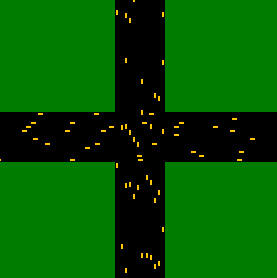|
A Reservation-Based Intersection Control Mechanism Kurt Dresner and Peter Stone |

|
This page is intended to supplement papers submitted for review to workshops, conferences, and journals. Current papers include:
-
Multiagent Traffic Management: A Reservation-Based Intersection
Control Mechanism
Kurt Dresner and Peter Stone
In the proceedings of The Third International Joint Conference on Autonomous Agents and Multi Agent Systems (AAMAS'04).
(PDF, gzipped PostScript)
We have proposed a reservation-based system for alleviating traffic congestion, specifically at intersections. As part of this endeavor, we created a custom simulator to model traffic at intersections. We created a Java applet version of the simulator so that the simulator could be viewed through a web browser. To view the applet, you will need the Java Plug-in.
The main result of our work can be summarized with the following three simulations. To run them, click on the links below. When the applet finishes loading, select "Run" from the "Simulator" menu.
- Traffic Light - cars must obey the
traffic signals. Using this system, cars are delayed by an average of
9.45 seconds relative to how quickly they could travel
without an intersection present.The traffic light has these parameters:
- Period: 30 seconds
- Alpha (fraction of period the light is green in the East/West direction): .45
- Beta (fraction of period the light is red in all directions between greens): .05
- Reservation System - cars can reserve time slots in the intersection. The granularity of the reservation system for this simulation is 4 (i.e. the system consists of a 4 x 4 grid of reservation tiles). Using this system, cars are delayed an average of 0.076 seconds - significantly less than when using a traffic light.
- Overpass - cars are always allowed to go and can pass through each other when travelling in different directions, as if there were an overpass in place. This system represents a theoretical lower bound: 0 seconds delay.
All of the above simulations are run with the following parameters:
- Car spawning probability for each direction: .01
- Number of lanes for each direction: 2
- Size of simulation: 400 x 400
You can also run the simulator with custom parameters.
Taking the approach to an extreme, you can see what the reservation system enables with 6 lanes in each direction and granularity of 48.
Copyright 2004, Kurt Dresner. This simulation is for demonstration purposes only. It is not to be used for any other purpose without express consent.